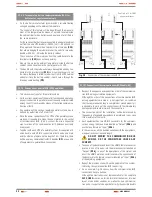
55
SALICRU
equipments in parallel, the hierarchy of «reserved by-
pass Slave» will be taken by the one with the highest
address among the «bypass Slave».
–
«Paral. Mst. Volt» voltage Master of the parallel system.
By default, the first UPS on normal operating (inverter in
operation), that the output switch
(Q2)
is turned «On».
–
«Paral. Slv. Vt.Rsv» reserved voltage Slave of the par-
allel system. Equipment on normal operating (inverter in
operation), that the output switch
(Q2)
is turned «On»
in 2nd place or subsequently (after the «Paral. Mst.
Volt» or «Paral. Mst. Vt.Rsv»). Initially, it corresponds to
the equipment with the highest address, excepting the one
from «Voltage Master». In case of failure of the Master,
it will take its functions.
–
«Paral. Slv. Volt» voltage Slave of the parallel system
(systems with more than two equipments only). Equip-
ment on normal operating (inverter in operation), that
the output switch
(Q2)
is turned «On» in 2nd place or
subsequently (after the «Paral. Mst. Volt» or «Paral. Mst.
Vt.Rsv»). It will become as «reserved voltage Slave»,
when it practise as «voltage Master». In systems with
more than three equipments in parallel, the hierarchy of
«reserved voltage Slave» will be taken by the one with
the highest address among the «voltage Slave».
Examples:
a) b)
UPS: Normal, Invert.
CFG: Mst. Volt
UPS: Shutdown,Off
CFG: Mst. Byp
•
Screen 0.2
: Internal firmware versions of both Digital Signal
Processor (“DSP Ver:”) and microcontroller (“uC Ver:”). In the
sample screen, “ver. 3.2 a” and “ver. 2.4 b” respectively.
•
Screen 0.3
: UPS Serial Number, expressed with 10 charac-
ters. Possible characters ranges are “0”-“9”, “A”-“Z” and also “
“ (blank space), “-“. See sample screen.
CONTROL
&
STATUS
OF THE UNIT
UPS ON STAND-BY
<ENT> TO START
<ENT> TO CONFIRM
<ESC> TO CANCEL
UPS RUNNING
<ESC> TO STOP
<ENT> TO CONFIRM
<ESC> TO CANCEL
BATTERY TEST
<status>
screen 1.0
screen 1.1
screen 1.2
screen 1.3
screen 1.4
screen 1.5
(ENT)
(ENT)
(ESC)
(
)
(
)
(
)
(
)
Screens 1.1 and 1.3 changes in
the diagram, depending on the
status of the equipment.
The same happens with the screens 1.6
and 1.8. Depending on the Smart Eco-
mode status, are exchanged.
SMART ECO-MODE
<ENT> TO ACTIVE
<ENT> TO CONFIRM
<ESC> TO CANCEL
SMART ECO-MODE
<ESC> TO DEACTIVE
<ENT> TO CONFIRM
<ESC> TO CANCEL
screen 1.6
screen 1.7
screen 1.8
screen 1.9
(ENT)
(ENT)
(ESC)
(
)
(
)
(ESC)
(ENT)
(ENT)
(ESC)
(ESC)
(ESC)
Fig. 45.
Screen submenu 1.0. Start up / shutdown.
7.3.2. ‘‘CONTROL AND STATUS OF THE EQUIPMENT" level
See Fig 45.
•
Screens 1.1, 1.3 and validation screen (1.2 / 1.4)
: to start
up and shutdown the equipment through the control panel.
To start up and shutdown the equipment, see sections 6.2 to 6.5.
•
Screen 1.5 and validation screen (1.2 / 1.4)
: to order a bat-
tery test. On the second row, information about the battery test
is given. Possible messages:
“NOT AVAILABLE“: The battery test is not available.
“PRESS <ENTER>“: Press <ENTER> to start the battery test.
“EXECUTING“: The battery test is running.
“SUCCESSFUL“: The battery test has been successful.
“NOT SUCCESSFUL”: The battery test has not been successful.
•
Screens 1.6, 1.8 and validation screen (1.7 / 1.9)
: to activate
and deactivate the Smart Eco-mode operating, described in sec-
tion 6.7 respectively.
7.3.3. ‘‘MEASUREMENT’’ level (screen menu 2.0). See fig. 46.
Due to the four different factory settings of the UPS:
1.- Three phase input / Three phase output (III/III).
2.- Three phase input / Single phase output -N- (III/I).
3.- Single phase input /Single phase output -L- (I/I).
4.- Single phase input /Three phase output -M- (I/III).
... the quantity of displays screens and their respective measure-
ments can vary depending on each case.
Table 5 shows the screens that ARE NOT AVAILABLE in some set-
tings, taking the “three phase input / three phase output” setting as
maximum conceptual exponent and represented in submenu of Fig.
46, which shows the measurement figures as an example.
For frequency converters and single phase equipments, the dis-
played measurements will be according to its condition.
















































